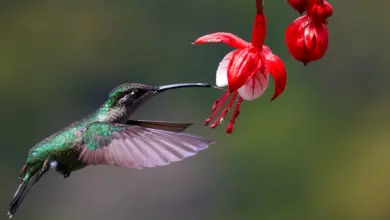Snowcaps or White-crowned Hummingbirds
The Snowcaps or White-crowned Hummingbird (Microchera albocoronata) is a tiny Central American hummingbird that ranges from southern Honduras to central western Panama.
Alternate (Global) Names:
Spanish: Colibrí Coroniblanco; French: Colibri à coiffe blanche; German: Schneekappenkolibri

Distribution
Snowcaps occur naturally in Honduras, Nicaragua, Costa Rica, as well as central and western Panama; but they are extremely localized and difficult to find.
They inhabit the Central American cloud forests; where they feed in humid montane evergreen forests. They are typically found high up in the canopy and along the edges of wet forest, as well as adjacent woodland.
The highest concentration occurs on the Caribbean mountain slopes, where they breed at heights of ~1,000 – 2,600 ft (300–800 m). After the breeding season, most will move down to the adjacent lowlands. However, some may move up to higher elevations to about 4,500 ft (1,400 m).
Subspecies and Ranges
- Microchera albocoronata albocoronata (Lawrence, 1855) – Nominate Race
- Found along both slopes of western central Panama.
- Microchera albocoronata parvirostris (Lawrence, 1865)
- Found along the Caribbean slope of southern Honduras, Nicaragua, Costa Rica and likely western Panama.
Description
The Snowcap averages 2.5 inches or 6.5 cm in length, including its short bill and tail. It weighs about 0.09 oz or 2.5 grams (less than a U.S. penny). The bill and legs are black.
This hummingbird is so tiny that it is easily confused with an insect. Its most distinctive feature is the male’s white cap, which is usually first noticed when the Snowcap flies through the dark forest understory.
Adult males: His plumage is mostly black, but the upper plumage has a striking reddish / purplish / bronze iridescence. His dark plumage contrasts sharply against the shining white cap on his head, for which this species was named. His outer tail feathers are white.
Adult females: Her plumage is mostly bronze-greenish above and dull white below. She has dull whitish outer tail feathers.
Immature Snowcaps look like females, but are generally duller. Their under plumage is greyer, and they have bronzed central tail feathers. As juvenile males mature and obtain his adult plumage, the purple plumage starts on the under plumage as a dark central line.
Calls / Vocalizations
The Snowcaps contact call is a high-pitched tsip. The male’s song is a warbling tsitsup tsitsup tsitsup tsuu ttsee.
Hummingbird Resources
- Hummingbird Information
- Hummingbird Amazing Facts
- Attracting Hummingbirds to Your Garden
- Hummingbird Species
- Feeding Hummingbirds
Nesting / Breeding
Hummingbirds in general are solitary and neither live nor migrate in flocks; and there is no pair bond for this species – the male’s only involvement in the reproductive process is the actual mating with the female.
During the breeding season, Male Snowcaps will join small leks (competitive courtship display by several males) to attract females. They will assemble in an area where they will sing for the females. These leks typically take place at the edge of the forest.
The male will separate from the female immediately after copulation. One male may mate with several females. In all likelihood, the female will also mate with several males. The males do not participate in choosing the nest location, building the nest or raising the chicks.
The female Snowcap Hummingbird responsible for building the cup-shaped nest out of plant fibers woven together and green moss on the outside for camouflage in a protected location in a shrub, bush or tree. She lines the nest with soft plant fibers, animal hair and feather down, and strengthens the structure with spider webbing and other sticky material, giving it an elastic quality to allow it to stretch to double its size as the chicks grow and need more room. The nest is typically found on a low, skinny horizontal branch.
The average clutch consists of two white eggs, which she incubates alone for just over two weeks, while the male defends his territory and the flowers he feeds on. The young are born blind, immobile and without any down.
The female alone protects and feeds the chicks with regurgitated food (mostly partially-digested insects since nectar is an insufficient source of protein for the growing chicks). The female pushes the food down the chicks’ throats with her long bill directly into their stomachs.
As is the case with other hummingbird species, the chicks are brooded only the first week or two, and left alone even on cooler nights after about 12 days – probably due to the small nest size. The chicks leave the nest when they are about 20 days old.
Diet / Feeding
The Snowcap Hummingbirds primarily feed on nectar taken from a variety of brightly colored, scented small flowers of trees, herbs, shrubs and epiphytes. They favor flowers with the highest sugar content (often red-colored and tubular-shaped) and seek out, and aggressively protect, those areas containing flowers with high energy nectar.They use their long, extendible, straw-like tongues to retrieve the nectar while hovering with their tails cocked upward as they are licking at the nectar up to 13 times per second. Sometimes they may be seen hanging on the flower while feeding.
Many native and cultivated plants on whose flowers these birds feed heavily rely on them for pollination. The mostly tubular-shaped flowers actually exclude most bees and butterflies from feeding on them and, subsequently, from pollinating the plants.
They may also visit local hummingbird feeders for some sugar water, or drink out of bird baths or water fountains where they will either hover and sip water as it runs over the edge; or they will perch on the edge and drink – like all the other birds; however, they only remain still for a short moment.
They also take some small spiders and insects – important sources of protein particularly needed during the breeding season to ensure the proper development of their young. Insects are often caught in flight (hawking); snatched off leaves or branches, or are taken from spider webs. A nesting female can capture up to 2,000 insects a day.
Males establish feeding territories, where they aggressively chase away other males as well as large insects – such as bumblebees and hawk moths – that want to feed in their territory. They use aerial flights and intimidating displays to defend their territories.
The male Snowcaps fiercely defend their feeding territories; however, due to its small size it is easily defeated by other larger hummingbirds.



